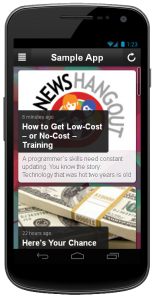About a year ago I wrote about cloud development tools for Android. At the time, there was only one available that had been specifically designed for Android development, though demand for such tools was on the rise. As a result, I focused much of my discussion on Codenvy (formerly Cloud IDE), which had been gaining recognition as a top cloud development environment for Web development, and which I expected to add Android support. Well, not only has it done that (for Android versions 2.1 and 4.2), the platform also integrates with a hosted device emulator service called Manymo, which is free with limited access to device images. Device emulator errors are a popular topic of discussion on Stack Overflow, so using a hosted emulator makes sense.  Why is a cloud IDE so appealing? Some folks just want to dive into app creation without all the intricacies of workspace set up. Compare the one-click start on Codenvy with the involved documentation for other IDEs. Even I prefer the ease of a one-click launch with a platform like Codenvy, and I enjoy the challenge of setting up a well-known problem IDE.
Why is a cloud IDE so appealing? Some folks just want to dive into app creation without all the intricacies of workspace set up. Compare the one-click start on Codenvy with the involved documentation for other IDEs. Even I prefer the ease of a one-click launch with a platform like Codenvy, and I enjoy the challenge of setting up a well-known problem IDE.
Other Cloud-Based Development Tools
Codenvy isn't the only cloud-based IDE supporting Android app development these days but it might be the only cloud-based native app IDE. Other hosted tools offer Web app creation with HTML5, Javascript, and CSS3, and often have a drag and drop design option for easy development. With them, you develop once and deploy everywhere -- they generate the code for different platforms for you. It sounds uncomplicated and exciting, but it’s troubling considering the difference between Android and iOS design requirements. Web-based drag and drop tools for mobile app creation have made incredible strides in the last year. Conduit Mobile offers a tool complete with an on-screen emulator preview. It offers both basic Web app modules and advanced custom code modules through its development platform. Apps created with it can take advantage of a few native device functions, though they offer a Web app experience for others. They can be submitted to iTunes, Google Play, and the Amazon Android App Store and can be tested on a physical device with Conduit's Revu app. To test an app, just download the Revu app and enter your app’s special test code. No development environment or buggy emulator required. Application Craft takes the drag and drop interface a step further by supporting both code-free creation along with Web app creation. Code can be created in the Application Craft IDE or uploaded from your local machine. Unlike Conduit Mobile, Application Craft's target audience is experienced Web developers. Code can be compiled as native iOS, Android, and Windows Phone using PhoneGap/Cordova. Telerik Icenium Mist is the most compelling hybrid app development platform I've tested. It is a cloud-based IDE for Web developers that offers a browser-based code editor like Application Craft and Codenvy but with additional integration of their own cloud backend, Everlive. Telerik offers the same build once, deploy to all experience as Conduit and Application Craft but with extra options. Looking at the total number of cloud-based mobile app IDEs, you can see the hybrid app is favored over native, and for good reason. Codenvy has done what others do not dare: It’s built a fully integrated development environment for Android in the cloud with access to native code and a proper emulator. It’s been working with Google Cloud Platform services since Google I/O in March. Though it hasn’t mentioned as much online, I think Codenvy is poised for acquisition by Google within the next two years. It only makes sense to include access to a robust cloud IDE from Chromebooks, especially after the release of the Chromebook Pixel.



